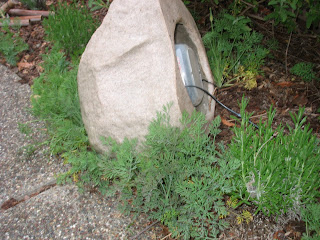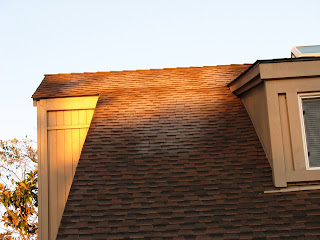Every year during the Going Native Garden Tour, I get lots of questions about our solar fountains. We have a lot of water features in our garden. Since the key to making renewable energy practical is to reduce energy consumption, I didn't want to add additional base load to our big solar panels by having fountains that run all the time off of the AC grid. So I've spent the last 6 years or so working with solar fountains, and this post tells you a little about them.
I've found that there are basically three kinds of solar fountains:
- Fountains in which the pump, solar panel, and water feature are completely integrated,
- Fountains in which the panel and pump are provided as a kit, and you simply install them in a water feature,
- Fountains that are made from bits and pieces that were bought for other purposes and need to be assembled and installed into the water feature.
In the first category is what The Lovely Wife calls the "Christmas fountain", because I gave it to her for Christmas a couple years ago. It is basically a plastic birdbath with an integrated solar panel and pump:
These kinds of fountains are really simple to install and use. You just place the fountain out in the sun and fill it with water.
The second kind require you to build some kind of water feature around the fountain. Here you can see a nice little fountain The Lovely Wife built in the front garden, with a blue bowel on top of a column of flat rocks:
The pump and the solar panel come as a kit, you just plug them together and set the solar panel out somewhere where it will get some sun but isn't too obtrusive. That's the solar panel in the background.
The other two solar fountains in our yard are the third type. Here you can see them running full bore on a sunny day. The first picture is the big fountain on the side, the second is the small one in the back:
These started out as the second type, i.e. a kit, but in addition to the solar panel, they had batteries for running at night. Unfortunately, the batteries didn't last very long, so I removed them and wired the panels directly to the pumps. This required some creative wiring as you can see here:
I have the junctions in a couple of plastic Tupperware boxes to keep it from getting too wet. With the big fountain, I can hide the box behind a large fern, but with the small one, I can't. So I bought a fake rock under which I hide the Tupperware box. Here you can see the Tupperware box sticking out when the rock is upside down, and how realistic it looks when the rock is properly positioned:
The fake rock is always a big attention hit during the garden tour. Also, it acts as good habitat for lizards. When I lifted it up recently, there was a big lizard underneath.
The large, 18V fountain on the side has a big pump and a large thin film solar panel:
It's really wonderful, like having a brook in our yard. On sunny days, the sound attracts hummingbirds.
The smaller, 6V fountain in back has its wiring concealed under the fake rock. It also has a thin film solar panel and runs into a water barrel:
The DC pumps on all the fountains are really poorly made and usually last between 1-3 years before they burn out. But since they only cost around $20 apiece, it's usually not a problem to replace them, though I had a hard time finding a pump for the 18V fountain. Good, reliable pumps are almost 10x more expensive. Silicon Solar has both the cheap and the reliable pumps, and a line of pump kits including those with battery backup. They have a nice selection, but sometimes their service isn't so prompt. I had to cancel an order last year because they still didn't have stock in 6 months after I placed the order. But unless you feel comfortable ordering over the Internet from China or know German (there are some really nice but expensive pump kits from German web sites), Silicon Solar is probably your best bet. I suppose, from an environmental perspective, throwing away a pump every 3 years isn't a particularly good use of resources, but all the parts on the pump can be recycled, and we have especially good recycling in our city, so I've so far favored the cheap pumps despite the hassle factor of having to replace them (and also because until last year, small reliable ones weren't available, at any price).
The latest trend in the cheap pumps is to wire a capacitor across them so that the capacitor slowly charges when there is not enough sun to run the pump continuously. When there is enough charge, the pump turns over once and water spurts out.
Though it is still cold here in northern California, spring is really here now and the wildflowers are spectacular. This double rainbow appeared the other day, perhaps a sign that the mild but wet winter we had this year is finally over:

























